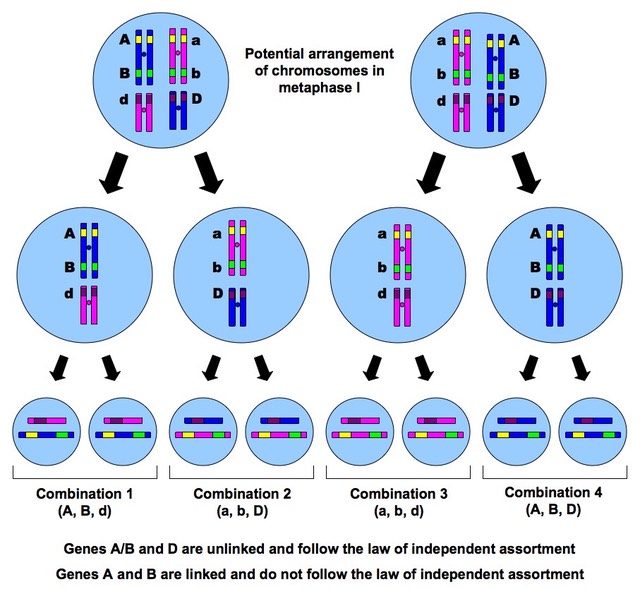10.1.1 Describe the behaviour of the chromosomes in the phases of meiosis
Interphase: Cell growth and DNA replication (duplication of DNA creates sister chromatid chromosomes)
Meiosis I
- Prophase I: DNA supercoils and chromosomes condense, nuclear membrane dissolves, homologous pairs form bivalents, crossing over occurs
- Metaphase I: Spindle fibres from centrioles (at poles) attach to centromeres of bivalent, bivalents line up along the equator of the cell
- Anaphase I: Spindle fibres contract and split the bivalent, homologous chromosomes move to opposite poles of the cell
- Telophase I: Chromosomes decondense, nuclear membranes may reform, cell divides (cytokinesis) forming two haploid daughter cells
Interkinesis: An optional rest period between meiosis I and meiosis II, no DNA replication occurs in this stage
Meiosis II
- Prophase II: Chromosomes condense, nuclear membrane dissolves (if reformed), centrioles move to opposite poles (perpendicular to previous poles)
- Metaphase II: Spindle fibres from centrioles attach to centromeres of chromosomes, chromosomes line up along the equator of the cell
- Anaphase II: Spindle fibres contract and split the chromosome into sister chromatids, chromatids (now called chromosomes) move to opposite poles
- Telophase II: Chromosomes decondense, nuclear membrane reforms, cells divide (cytokinesis) resulting in four haploid daughter cells
Summary
- Meiosis is the division of a cell to form four haploid gametes, all of which may be genetically distinct if recombination occurs in prophase I
Overview of Meiosis

10.1.2 Outline the formation of chiasmata in the process of crossing over
- Crossing over involves the exchange of segments of DNA between homologous chromosomes during Prophase I of meiosis
- The process of crossing over occurs as follows:
- Homologous chromosomes become connected in a process called synapsis, forming a bivalent (or tetrad)
- Non-sister chromatids break and recombine with their homologous partner, effectively exchanging genetic material (crossing over)
- The non-sister chromatids remain connected in an X-shaped structure and the positions of attachment are called chiasmata
- Chiasma hold homologous chromosomes together as a bivalent until anaphase I
- As a result of crossing over, chromatids may consist of a combination of DNA derived from both homologues - these are called recombinants
Crossing Over in Prophase I

10.1.3 Explain how meiosis results in an effectively infinite genetic variety in gametes through crossing over in prophase I and random orientation in metaphase I
- During anaphase I, homologous chromosomes separate, such that each resultant daughter cell (and subsequent gametes) contains a chromosome of either maternal or paternal origin
- The orientation of these homologues in metaphase I is random, such that there is an equal probability of the daughter cell having either the maternal or paternal chromosome
- As humans have a haploid number of 23 chromosomes, this means that there is 223 potential gamete combinations (over 8 million combinations)
- Crossing over in prophase I results in entirely new chromosome combinations, as recombination through gene exchange produces wholly original chromosomes containing both maternal and paternal DNA, resulting in near infinite genetic variability
- Other sources of genetic variation include random fertilisations, DNA mutations, chromosome mutations and non-disjunction
10.1.4 State Mendel's law of independent assortment
Gregor Mendel was a 19th century Moravian monk who demonstrated that the inheritence of traits (i.e. genes) followed particular laws:
- Law of Segregation: Each hereditary characteristic is controlled by two alleles, which segregate and pass into different reproductive cells (gametes)
- Law of Independent Assortment: The separation of alleles for one gene will occur independently of the separation of alleles for another gene
- According to the law of independent assortment, different allele combinations should always be equally possible
- However this law only holds for genes that are on different chromosomes - the law of independent assortment does not apply to linked genes
10.1.5 Explain the relationship between Mendel's law of independent assortment and meiosis
- The law of independent assortment relates to the random orientation of homologous chromosomes in metaphase I of meiosis
- Because the orientation of a homologous pair is random, and does not affect the orientation of any other homologous pair, any one of a pair of alleles on a chromosome has an equal chance of being paired with, or separated from, any one of a pair of alleles on another chromosome
- This means the inheritance of two different traits will occur independently of each other (provided the genes aren't linked)
Linked versus Unlinked Genes
